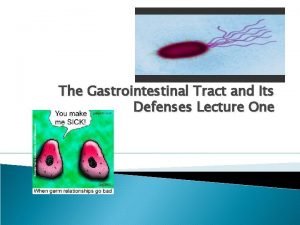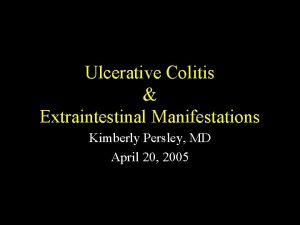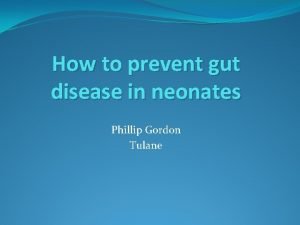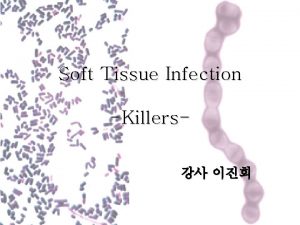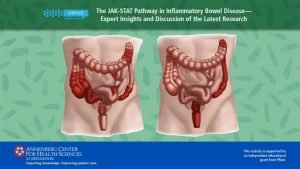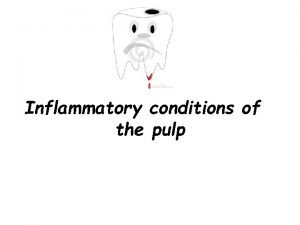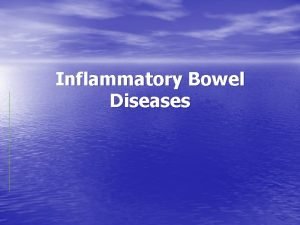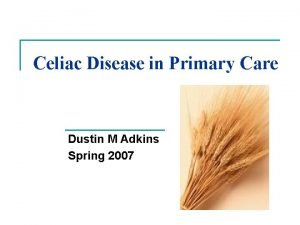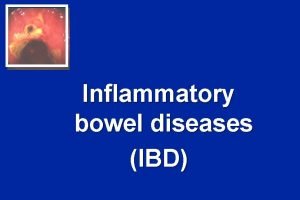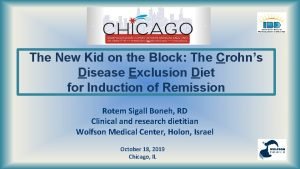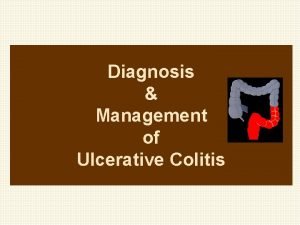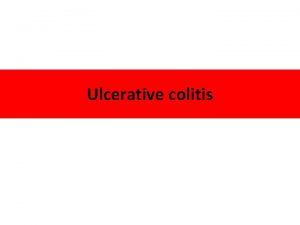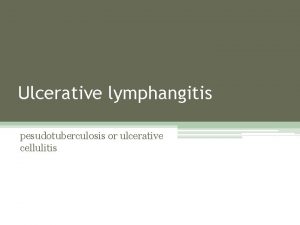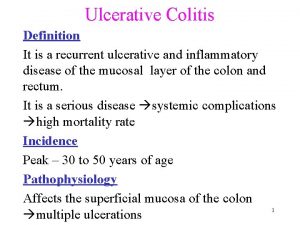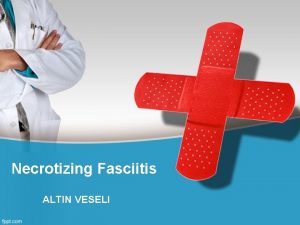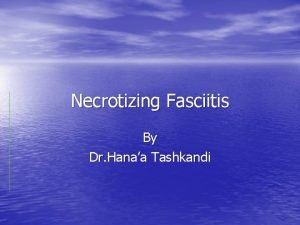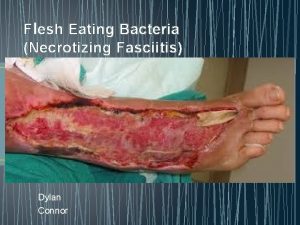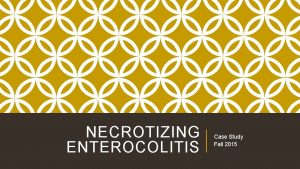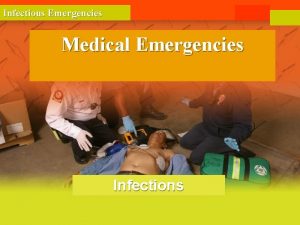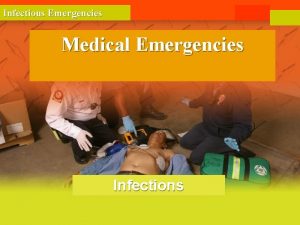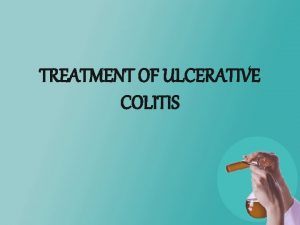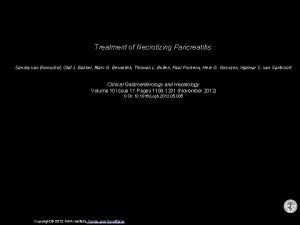treatment of Periodental Emergencies TREATMENT OF NECROTIZING ULCERATIVE













- Slides: 13

treatment of Periodental Emergencies

TREATMENT OF NECROTIZING ULCERATIVE GINGIVITIS

First Visit - A topical anesthesia is applied, the areas are gently swabbed with a cotton pellet to remove the pseudomembrane and debris. - The superficial calculus is removed. , Ultrasonic scalers are very usefull. -Subgingival scaling and curettage are contraindicated extend the infection to deeper tissues, causing a bacteremia -Rinse the mouth every 2 hours with a glassful of an equal mixture of warm water 3% hydrogen peroxide. # 0. 12% chlorhexidine are also very effective. q Systemic A. bio. Augmentin & Metronidazole

Second Visit 1 to 2 days later the pain is diminished. # - The gingival margins are erythematous, . Scaling is performed if sensitivity permits. calculus, is gently removed. The instructions to the patient are the same as those given previously Third Visit 1 to 2 days symptom free. #- Some erythema , gingiva slightly painful on tactile stimulation. #- SRP are repeated. The hydrogen peroxide rinses are discontinued, but chlorhexidine rinses can be maintained for two or three weeks.

TREATMENT OF ACUTE PERICORONITIS The treatment of pericoronitis depends on the severity of the inflammation, The treatment of acute pericoronitis consists of : 1. gently flushing the area with warm water to remove debris and exudate. 2. swabbing with antiseptic after elevating the flap gently from the tooth with a scaler. 3. The underlying debris is removed, and the area is flushed with warm water. 4. If the gingival flap is swollen and fluctuant, an anteroposterior incision to establish drainage is made with a #15 blade.

TREATMENT OF ACUTE PERICORONITIS Antibiotics can be prescribed in severe cases, After the acute symptoms have subsided, a determination is made as to whether the tooth is to be retained or extracted, If decided extracted: Bone loss on the distal surface of the second molars is a hazard following the extraction of partially or completely impacted third molars, ' and the problem is significantly greater if the third molars are extracted after the roots are formed or in patients older than their early twenties. To reduce this, third molars should be extracted as early as possible in their development.

-If it is decided to retain the tooth: the pericoronal flap by using periodontal knives or electrosurgery. It is necessary to remove the tissue distal to the tooth, as well as the flap on the occlusal surface. After the tissue is removed, a periodontal pack is applied. The pack may be retained by bringing it forwardalong the facial and lingual surfaces into the interproximal space between the second and third molars. The pack is removed after 1 week.

TREATMENT OF ACUTE HERPETIC GINGIVOSTOMATITIS Primary infection with herpes simplex virus in the oral cavity known as acute herpetic gingivostomatitis. This infection typically occurs in children, also occurs in adults. It runs a 7 - to 10 -day course and heals without scars. A recurrent herpetic episode may be precipitated in individuals with a history of herpes virus infections and by respiratory infections, sunlight exposure fever, trauma, exposure to chemicals, and emotional stress. TREATMENT q Initially use acyclovir ointment. using systemic acyclovir to prevent recurrent herpes virus infection , q Plaque, food debris and superficial calculus are removed to reduce gingival inflammation, q Extensive periodontal therapy should be postponed until the acute symptoms subside to avoid the possibility of exacerbation.

THE ACUTE PERIODONTAL ABSCESS Treatment The purpose of treatment of an acute abscess is to alleviate the pain, control the spread of infection, and establish drainage. Drainage can be through the pocket or by means of an incision from the outer surface.

Drainage through the Pocket 1. The area is anesthetized topically , Care is taken not to inject into the swelling itself. 2. A flat instrument or a probe is carefully introduced into the pocket in an attempt to distend the pocket wall for drainage. 3. A curette can then be gently inserted into the pocket to further drain and gently curette the mass of tissue internally.

Drainage through an External Incision #. After the application of topical anesthesia, local anesthesia is injected around the periphery of the abscess. #. A #15 blade is used to make a vertical incision through the most fluctuant part of the swelling, extending to an area just apical to the abscess, . #. Patients are instructed to rinse often with a solution of 1 salt in a glass of warm water and to return for follow-up evaluation the next day. # Antibiotics are prescribed for patients with elevated temperatures. bed rest is recommended. Analgesics are prescribed for pain

THE GINGIVAL ABSCESS the gingival abscess is a lesion of the marginal or interdental gingiva, usually produced by an impacted foreign object. Treatment: 1. Under topical and local infiltrative anesthesia, 2. The fluctuant area of the lesion is incised with a #15 blade, and the incision is gently widened to permit drainage. 3. The area is cleansed with warm water and covered with agauze pad, 4. After bleeding stops, the patient is dismissed for 24 hours and instructed to rinse every 2 hours with a glassful of warm water. When the patient returns, the lesion is generally reduced in size and free of symptoms, If the residual size of the lesion is too great, it is removed surgically.

Thank you
 Necrotizing ulcerative gingivitis
Necrotizing ulcerative gingivitis Ulcerative colitis treatment
Ulcerative colitis treatment What is nec in babies
What is nec in babies Necrotizing fasciitis hemorrhagic bullae
Necrotizing fasciitis hemorrhagic bullae Indication for exploratory laparotomy
Indication for exploratory laparotomy Filgotinib ulcerative colitis
Filgotinib ulcerative colitis Irreversable pulpitis
Irreversable pulpitis Proktosigmoiditis ulcerosa
Proktosigmoiditis ulcerosa Ulcerative colitis vs chrons
Ulcerative colitis vs chrons Ulcerative colitis hla
Ulcerative colitis hla Crohn's disease vs ulcerative colitis
Crohn's disease vs ulcerative colitis Ulcerative colitis crohn's disease
Ulcerative colitis crohn's disease Ulcerative colitis
Ulcerative colitis Ulcerative colitis diet
Ulcerative colitis diet
